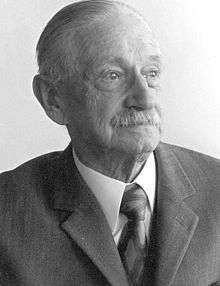Walther Meissner
| Fritz Walther Meissner | |
|---|---|
 | |
| Born |
December 16, 1882 Berlin, German Empire |
| Died |
November 16, 1974 (aged 91) Munich, West Germany |
| Residence | Germany |
| Nationality | German |
| Alma mater | Technical University of Munich |
| Known for | Meissner effect |
| Scientific career | |
| Fields |
Physicist Superconductivity |
| Institutions |
Physikalisch-Technische Bundesanstalt Technical University of Munich |
| Doctoral advisor | Max Planck |
Fritz Walther Meissner (German: Meißner) (December 16, 1882 – November 16, 1974) was a German technical physicist.[1]
Meissner was born in Berlin to Waldemar Meissner and Johanna Greger. He studied mechanical engineering and physics at the Technical University of Berlin, his doctoral supervisor being Max Planck. He then entered the Physikalisch-Technische Bundesanstalt in Berlin. From 1922 to 1925, he established the world's third largest helium-liquifier, and discovered in 1933 the Meissner effect,[2] damping of the magnetic field in superconductors. One year later, he was called as chair in technical physics at the Technical University of Munich.
After World War II, he became the president of the Bavarian Academy of Sciences and Humanities. In 1946, he was appointed director of the academy's first low temperature research commission. Laboratories were located in Herrsching am Ammersee until 1965, when they were moved to Garching. Meissner lived alone with his two dogs for the last several years of his life. Meissner died in Munich in 1974.
References
- ↑ Brickwedde, F. G. (February 1975). "Walther Meissner". Physics Today. 28 (2): 84–85. Bibcode:1975PhT....28b..84B. doi:10.1063/1.3068853.
- ↑ Walther Meißner and R. Ochsenfeld, Naturwissenschaften V21, p. 787 (1933).
External links
- "Walther-Meißner-Institute for Low Temperature Research". Bavarian Academy of Sciences and Humanities. 2016. Retrieved 2018-07-16.